What you’re paying for.
If you’ve opted in for SEO services, it can sometimes be unclear what you’re actually paying for.
You know you need it, but there are so many different approaches, and most of the work happens behind the scenes. Without a technical understanding, how do you know if someone is optimizing your website or is actually ‘optimizing’ a Mai Tai on a beach in Bali?
One approach, and our recommended approach, is to start with a technical audit of the website. This gives clients insight into the issues we’ve found that can impact their ranking. It also allows us to create an action plan for improving those issues, so there’s no guesswork in what’s happening behind the scenes. Every SEO client engagement starts with an audit.
Our system for auditing a website looks at over 150 of Google’s most targetable ranking factors and areas of website optimization. We take advantage of automated tools like SEMrush and Analytics software to supplement our audits, but when it comes down to it, our process is hands-on, personalized, and strategic.
A manual audit is one of the first things that we’ll do when you sign on for SEO. From this audit, we’ll provide you with an action items list of what should be done to improve your website and search presence and give you the option to take on this work yourself or have us do it for you.
Why a manual audit?
SEO isn’t just one thing; it’s many things that contribute to a greater whole. We believe in giving your website time with a real person, an expert trained to see a comprehensive picture of what’s going on and how to best optimize your system.
Every website is nuanced, with a unique purpose, structure and requirements. Our SEO audit works through all the avenues for improvement and prioritizes the lowest-hanging fruit. The outcome is an action-items list that works from the greatest potential outward.
The end goal of SEO.
At the end of the day, we and Google, want the same thing. We want to give website visitors the best experience possible – delivering what they want when they want it. Users don’t have time to sift through pages of search results, especially in voice search where one answer is all they’ll get. As a business, Google wants to show results that are the most relevant to the user, so that they’ll continue using Google’s platform.
In our SEO services, we focus on two things:
- Adding metadata and technical signals that tell Google what your site is about and how it’s structured. This makes your website the easy choice for Google when users search for your products and services.
- Enhancing website performance so that when a user gets to your site, they have the best experience possible. This makes your website the easy choice for your customers, one they’ll return to repeatedly.
How SEO fits into WebOps.
SEO has evolved from keyword stuffing and search engine hacks to a holistic, user-centric approach. At this point, Google is an AI-driven system that simply knows better. The space between search engine optimization and website optimization has shrunk to the point where keeping them separate is no longer necessary.
Our website operations (WebOps) services prioritize your website maintenance, support and growth. You know your business better than we ever could, so we’re not here to take over. We’re here to empower your marketing teams with best-in-class digital support, making your online presence less worrying about.
Turning audit to action.
We structure our audit and action-items list much like the report you’d receive following a car service. Want to see the details of your multi-point inspection? You’re more than welcome to. However, most of our clients care about the end result, our plan of action.
SEO predominantly happens in the background, so our action-items list provides a roadmap that shows exactly what we’ll be working on and when. With a plan in hand, you’ll never be left wondering what’s going on behind the scenes.
SEO is constantly changing. We keep things flexible so that we can adapt in real-time to changing algorithms and business updates. While staying adaptable, we’ll keep you updated to make sure that our actions align with your goals.
Breaking down your audit.
Below, you’ll find a list of some of the main areas that we focus on in our audit process. Select a list item to view more about what we look at, why it’s important, and how optimizing these areas can impact your website.
Account Setup & Analytics
The first place we start with any client is ensuring that we have access to their Google accounts. From Google Analytics and Search Console to Google Ads, Tag Manager, and Google My Business – we’ll get the relevant accounts connected or set up if they don’t already exist.
We’ll access the backend of your website, and look at what SEO plugins you’re using. We’ll look at the plugin settings, and ensure they’re properly configured to your website. We’ll add your website to our SEO software, set up your automated monthly reports, and start an initial site crawl. This will flag any critical errors that need to be addressed right away.
If you’ve had Google Analytics for a while, we’ll take some time to get a picture of your website users. We’ll look at where your traffic is coming from, who your visitors are, and what they’re doing on your website. This helps us to determine the quality of your website traffic and how engaged your visitors are.
Where possible, we like to compare traffic on a year-over-year basis. This best accounts for seasonal fluctuations. We’ll look at how your traffic has changed over time, comparing spikes and dips with Google Trends. This helps us to determine if significant changes are unique to your business, or if blanket changes in your industry can explain them.
Key takeaway: Get set up properly to gather meaningful data.
Structure & Crawlability
It’s always surprising how many sites we review that is set to “noindex”. This simple line of code is added to a website while it’s being built, telling Google not to include the website or page in the search results just yet. It’s meant to be temporary and removed once the website launches, but if forgotten, blocks all SEO efforts going forward.
While reviewing its structure, we’ll make sure that your website is indexable and crawlable. We’ll optimize your XML sitemap and robots.txt file, ensuring that we’re giving crawlers clear direction on what we want crawled and what should be avoided.
We’ll ensure that your site title and tagline represent your businesses and that navigation is easy and understandable. This is done by creating a site hierarchy that moves from the broadest page – your homepage – to more specific sub-pages and posts. Like an index in a book, giving context on how pages and posts are organized will help Google (and your visitors) quickly find what they’re looking for.

Key takeaway: Establish good information architecture for bots and humans.
Security
Trust signals and security precautions are incredibly important to search engines and your users. This is especially true for e-commerce websites, where users enter sensitive billing and location information. If visitors don’t trust your website, they’ll likely go elsewhere.
SSL Certificates
For optimizing site security, we start by checking that the site has a valid SSL certificate. This is important for securing online communications. We love the analogy of sealing a letter in an envelope before sending it in the mail. An SSL certificate enables an encrypted connection for websites that keeps shared data secure.
Site Plugins
From there, we’ll remove any themes that are no longer in use, keeping only the necessary backups and sub-themes. We’ll remove any unused plugins, and make sure WordPress and the remaining plugins are all updated to their latest versions.
When using plugins, we believe less is more. While there may be a “plugin for that” for most web applications, plugins are susceptible to breaking code during updates. They also create similarities between a large volume of websites, making them a good access point for website hackers. Where possible, we’ll replace plugins with baked-in code that won’t break or introduce vulnerabilities.
Defender Pro
One of the plugins that we recommend is WPMUDEV’s Defender Pro for securing WordPress websites. This acts as an all-in-one security hub for running security scans, managing your blocklists and firewalls, enabling two-factor authentication (2FA), and actioning hardening recommendations. It offers a great solution for scanning, securing and monitoring your website for hacks, and we implement it for all our clients in the WordPress ecosystem.
Spam Cloaking
To check that a website hasn’t already been hacked, we’ll do a search of all the indexed pages in Google, and make sure that they’re all supposed to be there. Here’s an example of compromised content in a past client’s website.
Cloaking can go unnoticed without a direct search. If we find anything out of the ordinary, we’ll make sure to get this resolved.
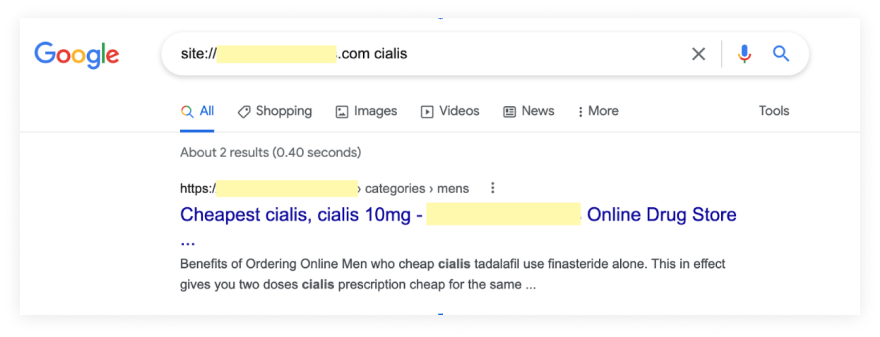
Domain Security
Domain name system (DNS) servers are used in converting website domains to IP addresses. This turns easy-to-use domain names, like twirlingumbrellas.com, into machine-readable data (like 184.70.240.22, our IP address). We like the analogy of DNS being the internet’s phone book, giving users an easy way to find what they’re looking for amidst a ton of numerical information.
Because data is being sent and received in different formats, DNS by itself is not secure. This used to be an area of weakness for attacks until security was advanced in the 1990s. The solution is DNS Security Extension (DNSSEC), a suite of extension specifications that uses digital signatures to strengthen authentication. If you’re interested in learning more, we recommend ICANN’s article on DNSSEC.
In our audit process, we use a DNS Security Extensions (DNSSEC) analyzer to determine if there are any problems with DNSSEC-signed names and zones. This is done to mitigate security risks, verifying and authenticating DNS data and integrity.
Key takeaway: Keep things secure & trustworthy.
Accessibility & Compliance
Canadian accessibility standards differ from the US, making general requirements seem a bit unclear. In Canada, regulations differ based on where your website was established, your reach (provincial or national), the size of your organization, and if you’re a private business or public sector organization. Accessibility.com has a great article on Canadian Digital Accessibility Laws if you’d like to read into this further.

As part of our audit, we’ll check that your website meets accessibility standards. We follow material design philosophies and W3Cs Web Content and Accessibility Guidelines (version 2.1). This ensures our projects are user-friendly to those with disabilities.
We’ll also make sure that all standard policies are in place, including a privacy policy, terms of service & cookies policy. While you’re ultimately responsible for ensuring and maintaining legislative compliance with your website, we can help with implementation. We’ll recommend ways to support your audience’s diverse needs.
Key takeaway: Promote inclusivity & transparency.
Domain Health
Your domain may be new to you, but does it have a dark past? Domains can store important historical information, such as blacklist status, which can be transferred to new ownership. Activities from other domains can also have a negative impact on yours, linking spammy information to your website. This can damage your site’s reputation with Google, much like being friends with the ‘wrong crowd’.
While they’re not ranking factors, we look at domain and page authority when auditing a website. We’ll look at who’s linking back to your website, using a spam score to determine if these links are causing harm. If toxic links are found, we’ll work with Google tools to request that those links be disavowed.

We’ll search your domain on Whois – a query/response protocol that public records who owns your domain. We’ll review the ownership and other identification data related to your website. We’ll make sure that important information is visible and accurate, and that nothing is expiring soon or needs urgent attention.

We’ll use tools like MxToolBox to test your mail server & review any warnings associated with blacklists, your web server and DNS.
Key takeaway: Ensure a good reputation.
Speed & Performance
Slow websites kill people. It’s a bold statement, but the math adds up. If you take the number of searches Google receives every day (currently over 3.5 billion), we can estimate that if each led to a website that was 1 second slower, that would equate to over 110 years of wasted time. That’s more than a single lifetime wasted, in just one day.
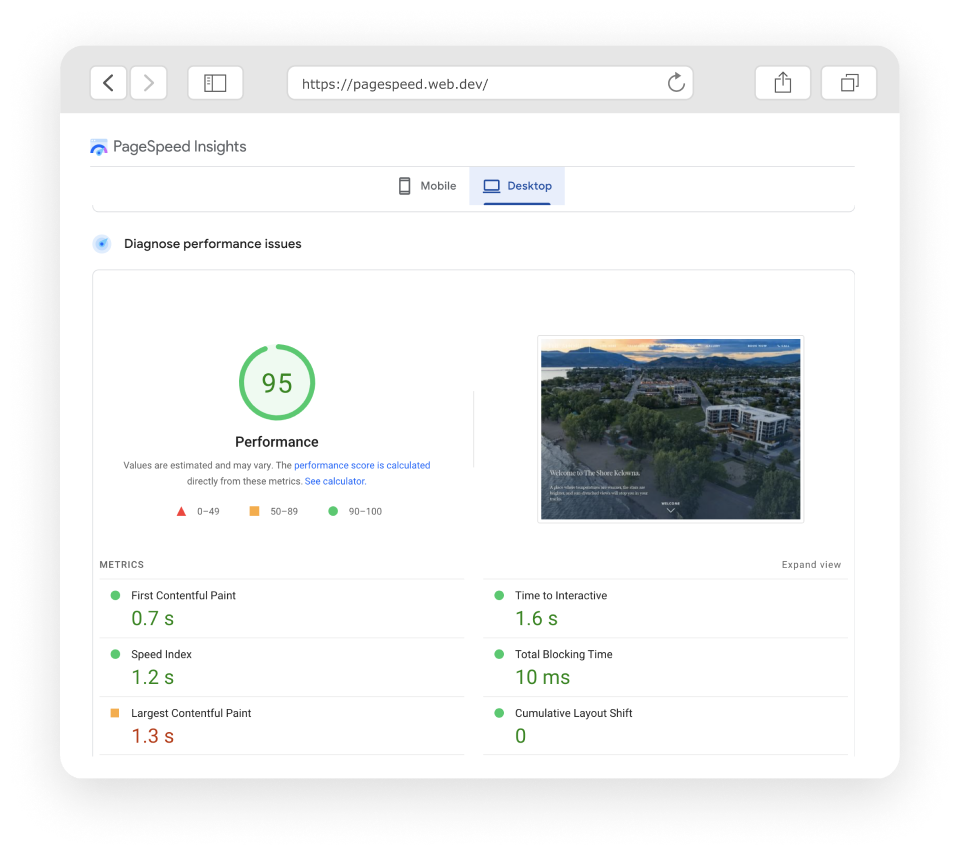
Google isn’t into wasting time, and neither are we. Just last year, Google developed a new set of ranking factors called “Core Web Vitals”, dedicated to measuring user experience quality. These metrics score how quickly page content loads, how quickly a webpage can respond to a user’s input, and how stable content is as it loads. If you’re interested in learning more about it, check out our Core Web Vitals article.
In our audit process, we use tools like Google’s PageSpeed Insights, GTMetrix and Core Web Vitals to analyze how fast a website is on desktop and mobile, and how efficiently users are interacting with it. We’ll work through the opportunities for improvement, such as reducing unused JavaScript, serving images in NextGen formats, and properly sizing images.
Pantheon Hosting
In your WebOps retainer, we’ll always recommend switching to Pantheon hosting. While there are many reasons that we love Pantheon, their advanced Redis™ caching system and lightning-fast content distribution network (CDN) make it an easy choice for high-performing websites.

Key takeaway: Make it fast & reliable.
Mobile Friendliness
Mobile experiences now account for over half of website traffic worldwide. We can use Google Analytics data to determine whether your customer base is predominantly mobile or desktop. It’s likely that many of your customers are interacting with your business on a small screen, so your website needs to take, at the very least, a mobile-friendly approach.
Part of our audit process is to review Google’s Mobile-Friendly Test and the Mobile Usability section in the Google Search Console. We’ll conduct a manual review to ensure that mobile hamburger menus are functioning correctly, all content is visible and properly sized, and nothing is lost in tiny translations.
Key takeaway: Make it mobile-friendly.
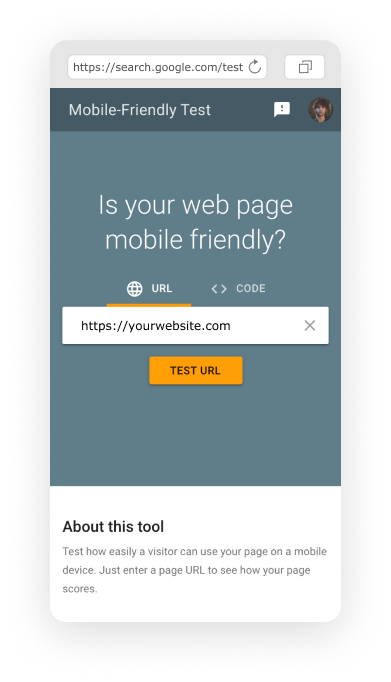
Metadata for Posts & Pages
Metadata is data about data. This is the supplementary information that we place within a website’s code that’s hidden from your visitors, to be read only by website crawlers. Metadata helps Google understand your website and gives suggestions for what Google should show in search results.
Our process starts with the broad addition of site titles and descriptions to your website pages and posts. We’ll do the same for custom post types, categories and tags, targeting any pages that are indexable. This process can take hours to months to complete, depending on the size of your website.
Key takeaway: Summarize written content for website crawlers & search engines.
Metadata for Images & Videos
Image and video metadata includes things like alt tags, titles and descriptions, and even filenames. This is particularly important for showing up in image or video-based search results, which are becoming increasingly prevalent in search engine results pages (SERPs).
Alt tags are descriptive text that’s added to an image to tell visually impaired and screen readers what the image shows. Previously seen as a key place for keyword stuffing, Google has gotten more strict about alt tags being used for their intended purpose. At Twirling Umbrellas, we work to find the balance between including keywords in alt tags while ensuring that the tag is visually descriptive. This is done by using purposeful images that are directly related to the page or post topic.
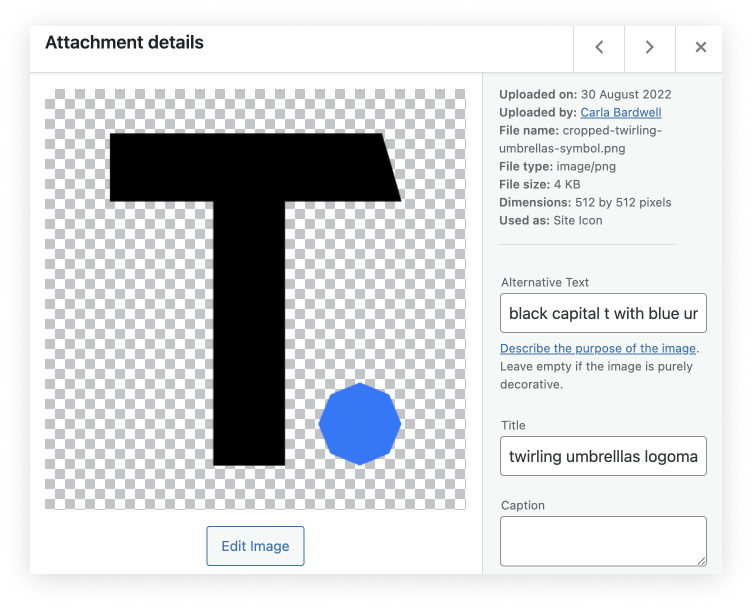
Key takeaway: Describe image-based content for website crawlers & the visually impaired.
Local SEO
If you have a business model that includes walk-in customers, local SEO is vital to getting customers through your door. Local SEO includes everything from name-and-place (NAP) citations, to geo-tagged images and an active Google My Business page.
One of the main goals of local SEO is keeping your store information accurate and up to date across all channels so that customers can easily find you and your products. Ecommerce product optimization and local SEO go hand-in-hand, ensuring that customers know which products are in stock and where to find them.
Adding an embedded map or link to your location on Google or Apple Maps is a great place to start promoting your location. We’ll look at your contact page, check that it includes the necessary information, and ensure that location indicators are present in your keyword-rich content.
Google My Business
Many people think of Google My Business as a social profile, and rightfully so. This platform lets you share posts, promotions and important business announcements. You can share images of your business interior, exterior, products, team and work, and encourage customers to do the same.
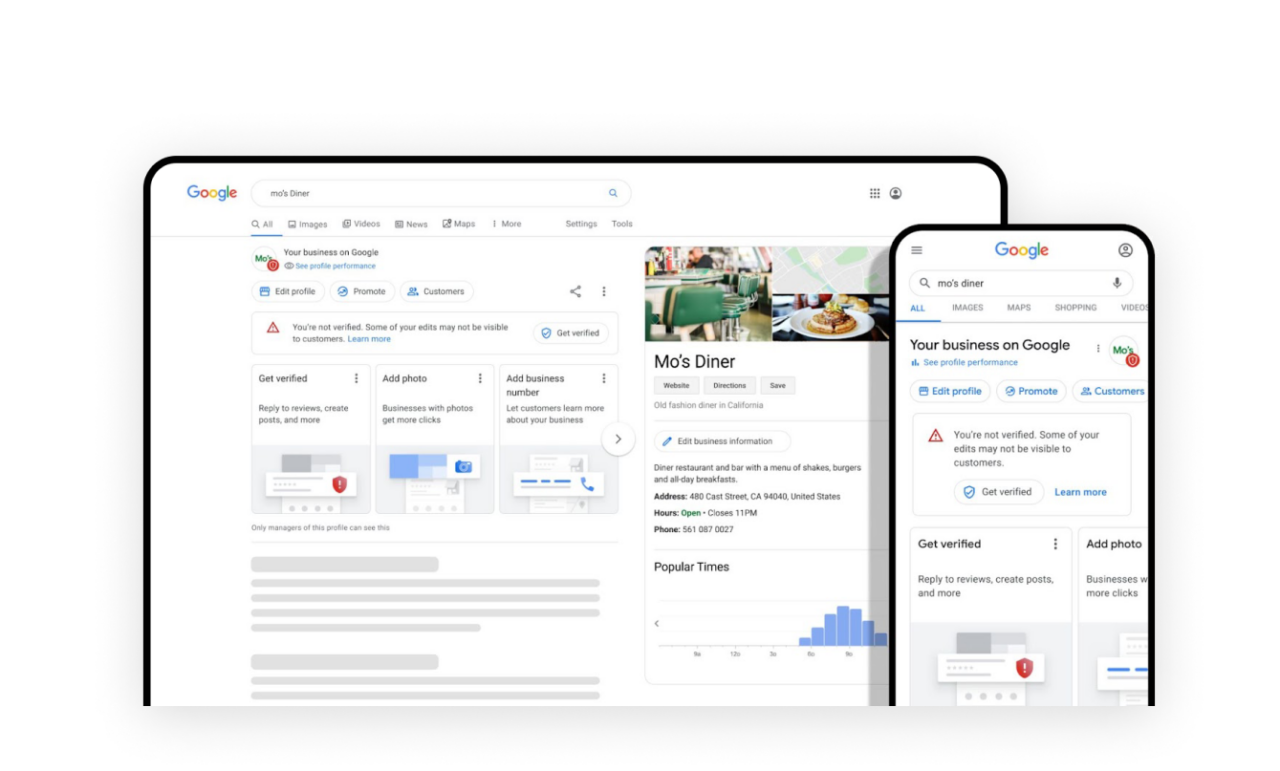
Much like reviews (which are also managed on Google My Business), customer photos are a great way for prospective customers to visualize the experience you offer. This builds first-hand trust and can be a great source of free marketing.
In our audit process, we’ll check your business profile. We’ll make sure that it’s up-to-date and active, and provide recommendations for getting the most out of this platform.
Pro tip: Google My Business provides a direct, shareable link to request new reviews from your customers. We recommend adding this link to your email signature so that it’s easily accessible and top-of-mind. When a customer compliments you on your products or services, having a review link ready can be a great way to build a top-notch reputation.
Key takeaway: Direct visitors to your brick-and-mortar.
Rich Snippets & Schema
After making sure the basics are taken care of, rich snippets & schema are the second phase of metadata review. We’ll take a look at what Google is showing for your business in search results using a rich results test, and provide more options by adding them into the code.
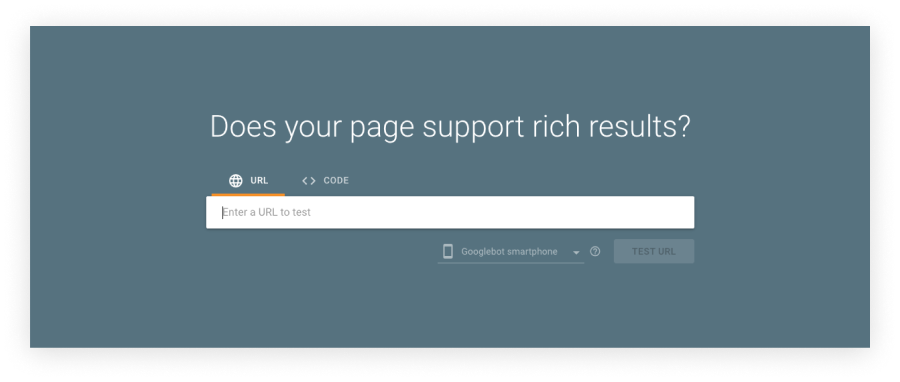
Rich snippets take up more real estate in search, which helps to increase your click-through rate (CTR). There’s only so much space on a search results page, so increasing your presence also limits what’s left for your competitors.
Like a manual for your website, structured markup provides the instructions for Google’s Rich Snippets. As part of your audit, we look at the structured markup (typically from Schema.org) in your website’s code. If there are Schemes present, we’ll make sure that they’re comprehensive and formatted correctly. If not, we’ll add this to our to-do list.
Key takeaway: Help Google understand your business.
Keyword & Competitor Research (Rankings & Relevancy)
Keywords are important, but it’s worth repeating: Google is an AI-driven system that simply knows better. While keywords used to be the foundation of SEO, stuffed into every nook and cranny of a website, they’ve gone from being everything to simply being a tool in our arsenal.
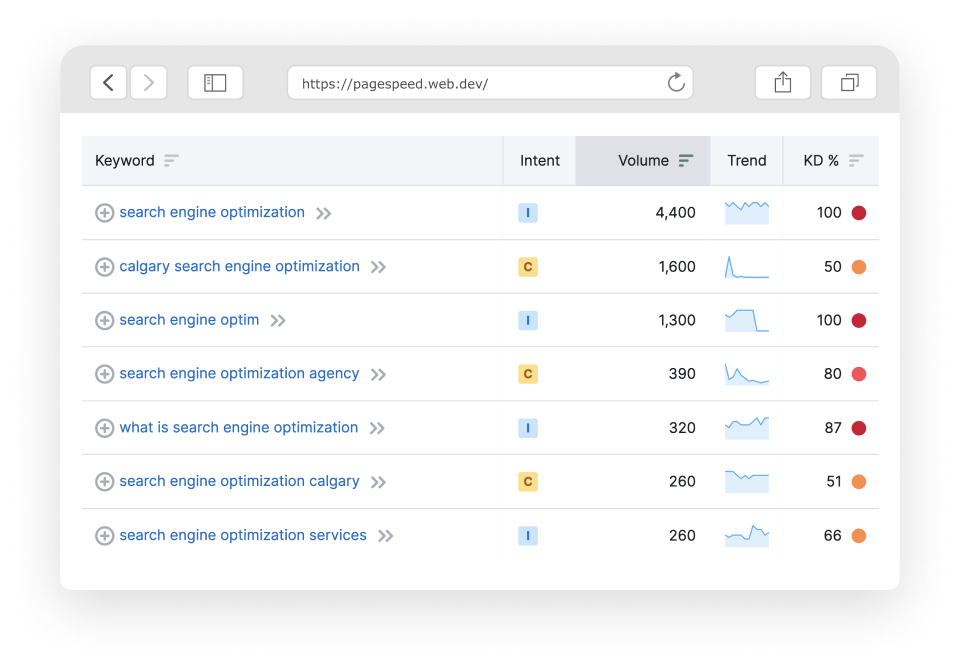
Today Google uses hundreds of different factors to determine if your website is the best option for a user’s search query. It’s gotten better at “reading between the lines”. With the advent of voice and location-based searches, Google pulls signals from all over to help identify what you’re actually searching for – even if you’re not quite sure.
Keyword Rankings & Traffic
With users searching in so many different ways and Google piecing it all together, focusing your efforts on specific search terms can skew your data. For example, if you’re a running shoe company and are only keeping your eye on the rankings for “running shoes”, you might miss a huge increase in “athletic shoes” or “sneakers”. Your metrics are also more susceptible to algorithm changes and updates. When your focus is too small, things can actually get messier.
In our process, we like to see the big picture. If your website is built to bring in relevant traffic, does it matter what search terms your customers use? If your organic website traffic (visitors from search engines) tripled in the last year, does it matter if you’re no longer in the top rankings for a handful of keywords?
We don’t think so. We like representative data, stable numbers and real results. This is why we’re big advocates for using organic traffic as a key performance indicator (KPI).
Keyword & Competitor Research
Keywords are important because they help tell Google what a website is about. Part of our SEO services include performing a keyword and competitor analysis. This multi-phase process identifies the keywords you’re currently ranking for, who your competitors are what they’re ranking for, and keyword opportunities in your industry.
With each keyword or keyphrase that we look at, we identify two important metrics: keyword difficulty and search volume. These numbers tell us how much competition there is for a search term and how many people (on average per month) are actually searching for it. We’ll look for terms that have low difficulty and high search volume – filtering down until we’re left with those with the greatest potential for your business.
Use Cases for Keywords
The end result of this research is a list of keywords that are worth utilizing in your website. We’ll include these in the content and often use this same research for other services such as Google Ads or building a content strategy for your blog.
Cluster keywords (groups of related keywords) are a great way to help Google understand your website and business. If there are supporting terms that can help foster understanding, we’ll be sure to include these in your content. This research is something that we build on over time. We’ll continue to stay updated with industry changes and trends and update our keyword research accordingly.
If keyword rankings are important to you and you have terms that you’d like to monitor over time, certainly let us know. We can add these to your monthly reports for you to view. For our services, we won’t be worrying about monthly fluctuations unless we see global changes or drops.
Key takeaway: Conduct research & act on traffic-building opportunities.
E-Commerce: Product Optimization & Checkout
If Google detects that a user’s intent is to purchase, the entire search experience transforms into a shopping experience. Having your products optimized will help Google to pull them into their displays, increasing the space that you take up and the number of your products being promoted. Take this Under Armour example:
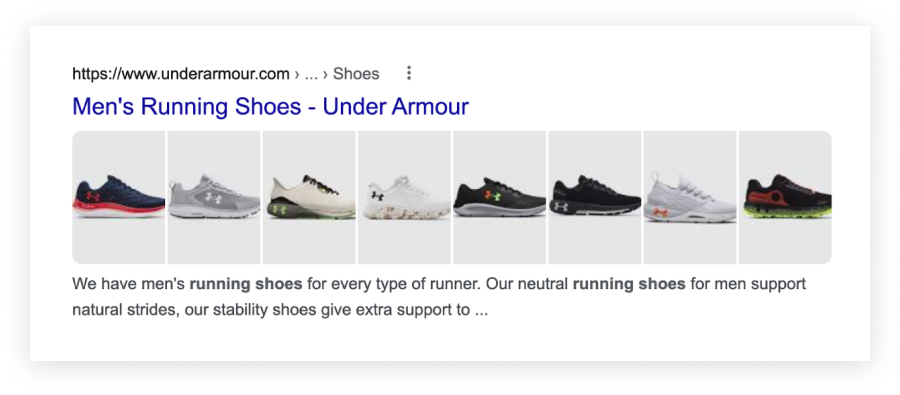
Showing results for Running Shoes, Google not only links to the Under Armour website, but starts to pull products in dynamic image extensions. Since these products are well-optimized, each image is linked to a product page, allowing users to shop right from the SERP.
As part of our audit, we’ll review your online store’s products. We’ll check if they’re optimized and that the add-to-cart process is quick and easy. We’ll review the checkout process, looking for any sticking points along the way. If necessary, we’ll recommend heat mapping and video recording software like HotJar to help to better understand your user experience.
Other important E-commerce factors we’ll review include your shipping and return policy, contact information, customer support options, product reviews, security and payment processing. We’ll check for abandoned cart reminders and newsletters, providing recommendations for email marketing and automation.
Key takeaway: Make online shopping a breeze.
Content Quality & Audit
If your website has been operating for a while, there will likely be a need for cleaning up outdated and duplicate content. We often come across websites with multiple pages and posts for the same thing, which can confuse Google and your website visitors. As part of our process, we’ll conduct a blog content audit.
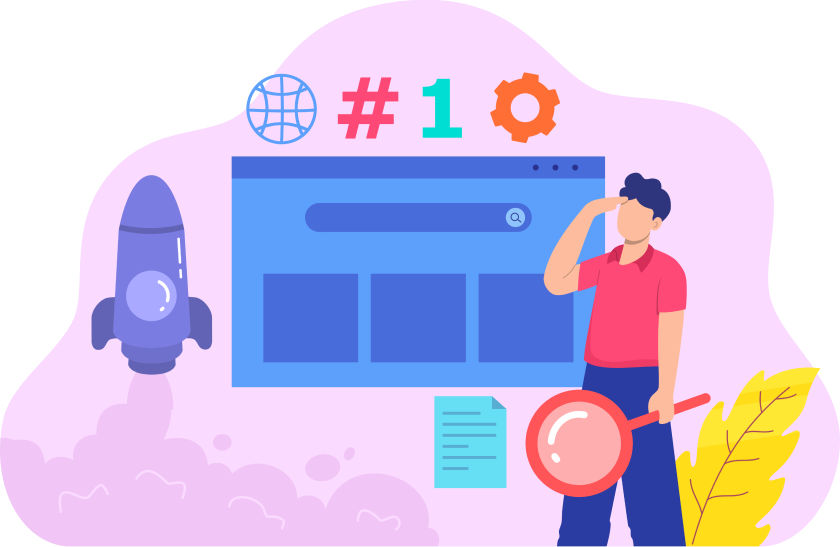
Things included in a content audit include:
- A list of pages and posts to consolidate.
- A list of pages and posts that should be expanded upon; if the content is too short or without substance, it won’t add value to your website.
Much like getting a haircut, getting rid of anything that’s outdated or doesn’t serve a purpose will help to strengthen what’s remaining. For pleasing search engines and readers, quality over quantity is always best.
Key takeaway: Clean up your existing content.
Duplicate Content & Redirects
There are instances where a website, especially an ecommerce website, has duplicate content that’s purposeful. For example, if you have a category for white shirts and a category for golf shirts, you might end up with two different product pages showing the same white golf shirt. In this case, we’ll review to make sure that the duplicates aren’t confusing to your customers. If the structure makes sense, we’ll add canonical tags to ensure that Google only sees one version.
Another case for duplicate content is between websites, often seen with guest posts and press releases. If you have two posts that are exactly the same on different websites, these posts can compete with each other and negatively impact search results. To prevent this, we can add a canonical tag to the original, telling Google which one is correct to give credit to and show in search.
By cleaning up your content and getting rid of duplicates, we can help put your website’s best foot forward.
Key takeaway: Get rid of redundancies.
Link Quality & Building
Broken Links
One of the first things we’ll check when auditing your site links is that nothing is broken. Broken links are quite common, especially when you have a lot of older blog content. We’ll work to fix any error 404 pages, creating redirects where necessary.
Redirects
Redirects are a powerful tool that shuttle website traffic from one page to another. However, if overused, they can create chains that are confusing to search engines. Crawler’s will bounce from link to link, wasting time that could be better spent on actual content. There’s only so much time that a crawler will spend trying to find the right page, before giving up and looking elsewhere.
In our audit, we’ll look for any redirect chains and eliminate them where possible. We’ll do that sparingly if a link is broken and we need to redirect traffic elsewhere. As a policy, we like to review redirects every 6 months. We’ll use Google Analytics to determine if the original link is still getting any traffic, and remove those that are no longer necessary.
Link Building
Links create a web of connections between your website and other websites: external links going out and backlinks coming in. Links help to demonstrate authority in a subject, and are a good indicator to Google of what your website is actually about. Like references on a resume, high-quality backlinks tell Google that you’re trustworthy and worth promoting.
Within your website content, we’ll ensure you’re linking to quality sources. We’ll look at who’s linking back to you and for opportunities to build links from reputable sources. We’ll gather some insight from your competitors, seeing who’s linking to them and if those same links would be worth pursuing for you.
In our link-building efforts, we believe in quality over quantity. We’ll work with you to steadily build up your online reputation, without using risky illicit practices that could lead to penalization.
Internal Links & Orphans
As part of our audit, we’ll also take a look at the link structure within your website. We’ll ensure that your website hierarchy makes sense and is easy to navigate. We’ll work through your blog posts to make sure that they are interconnected, keeping users on your website for longer, effortlessly flowing from page to page to gather information.
We’ll make sure that each page on your website has a purpose, and that there are no orphan pages (those without internal links) present.
Key takeaway: Build & direct traffic.
UX Design & Review
When it comes to a great website, looking good just isn’t good enough. This is where UX Design comes into play, a design process that always considers and prioritizes user experience. While our design team works hard to create beautiful websites, functionality is always top of mind.
If you’ve had your website designed and developed by us, this final part of the audit process may not be necessary. However, if you’re coming from somewhere else, we’ll take some time to check that your website’s design matches its purpose.
On top of doing a sitewide spelling and grammar check, we’ll check that all headings are tagged correctly and that their formatting creates a functional hierarchy. We’ll check that your content is easy to interact with and that nothing critical is missing in the design.
UX design signals and SEO targets are often one and the same, with many crossovers in goals and objectives. Working towards the best possible user experience, purposeful design and functionality are a big part of modern SEO.
Key takeaway: Consider a purposeful design.
Conversion Optimization
Conversion Rate Optimization is the process of enhancing a website to improve the number of leads it generates. While this isn’t included in our audit, we often come across areas for improvement while we work through our audit process. We’ll provide these recommendations alongside your action items list, which can be reviewed with your account manager if you’d like to take action.
If goal tracking is important to your business, we’ll set up events in Google Analytics 4 to gather data on important conversion actions. We can use HotJar to visualize user experiences and combine this data to make informed decisions about areas for improvement.
Key takeaway: Highlight opportunities for improvement.
Armed with a plan.
Getting users to your website is only half the battle, and SEO can’t be the extent of your marketing. This piece of the puzzle is part of a greater whole that captures search interest and keeps customers engaged and coming back for more.
At Twirling Umbrellas, we specialize in building and supporting enterprise-level WordPress websites. We empower and support marketing teams, making your online presence less worrying about. Covered by a thorough audit and actionable list, you can rest assured that we’ve covered your website performance.
